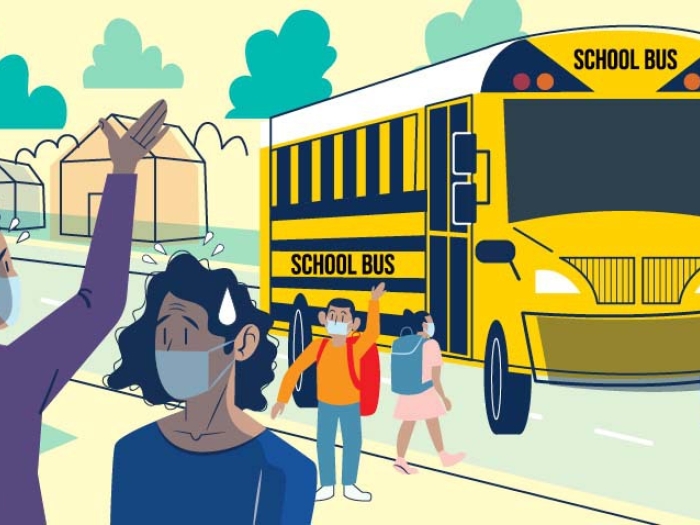New mandates require children ages 2-4 to wear masks at places like stores, daycare and camps. Specialists share their secrets to helping kids comply.
8:47 AM
Author |

Toddlers seem developmentally primed to protest. That means learning to say no to new foods, sharing a toy and yes, even refusing to keep on a face mask.
During the pandemic, mask mandates in many parts of the U.S. only applied to children ages five and older. But as some areas see a new COVID surge, along with increasing infections among pediatric populations, the requirement may extend to younger children too.
In Michigan a new mandate requiring toddlers ages 2-4 to wear masks goes into effect April 26 as health officials aim to ensure a "good faith effort" in settings such as daycare centers, preschools, camps and other public areas.
The masking order follows recommendations from the American Academy of Pediatrics and Centers for Disease Control and Prevention guidance.
The CDC has advised that children younger than two not wear masks.
At Michigan Medicine C.S. Mott Children's Hospital, the Child Life team is used to helping children of all ages cope with hospital situations they may be hesitant about, including pokes, medical treatment and other potentially scary scenarios. Now, three Mott child life specialists share their best tips for equipping families with tools to promote health and safety for the littlest community members.
1. Use child-friendly language.
Kids respond best to very simple, positive, gentle and concrete explanations, says certified Mott child life specialist Courtney Hoffenbacher.
"Explain that just like it's a rule that everyone wears shoes when we go to the store, it's also a rule right now to wear a mask when we leave our house," she says.
"For older toddlers, it may also help to tell them that face masks protect us from other people's germs and protect them from ours. And that it will help keep us and others healthy and safe."
2. Model mask-wearing.
Children pick up on behavior from peers and adults, which is why it's so fun for toddlers to pretend to have conversations on a toy phone or want to use tools.
If they see parents and older siblings wearing masks and that it's a rule that applies to everyone, they will likely want to mimic that behavior too, Hoffenbacher says. But parents should keep in mind that stubbornness and resistance during these ages is to be expected.
"Just like with many things, forcing a child to wear a mask can lead to a battle," Hoffenbacher says. "Control is a vital part of a child's development and understanding. Instead of a power struggle, model for them how to wear a face mask to normalize it and make them feel more comfortable."
"Kids are greatly influenced by the people around them."
MORE FROM MICHIGAN: Sign up for our weekly newsletter
3. Practice through play.
"While words are important, children process emotions and learn through play," says certified Mott child life specialist Mary Harwood.
She recommends planning ahead for any outing requiring a mask, whether at a doctor's appointment, store or daycare, through practice that feels fun.
While words are important, children process emotions and learn through play.Mary Harwood, certified child life specialist
Parents might pretend to be a doctor while wearing a mask and practice taking masks on and off or wearing it while pushing a pretend cart at the store. Or they may take turns with their child putting masks on a favorite doll or stuffed animal.
"You might compare the face mask to dress up or superhero masks or even play peekaboo with the masks to prepare younger children," she says.
Drawing face masks on characters in coloring books or coloring pictures of people wearing masks may also help. Mott offers families printable coloring pages to encourage mask wearing.
4. Let them choose the mask.
Giving children any sense of control may go a long way. They may not have control over the rule, but maybe you can let them pick the color or design of the mask, Harwood suggests.
Crafty parents may even consider making a mask with their child using their chosen pattern.
"Just remember that it's not recommended to draw on or decorate any paper or surgical mask because it could reduce safety," she says.
5. Take baby steps.
Mott certified child life specialist Jessica Oswald recommends giving children a small prize like stickers or little treats whenever they're able to wear a face mask for a short amount of time.
They could start out wearing masks during a favorite TV show or keep it on for periods of time on a walk outside. And make sure they have time to process the concept before needing to apply it for longer stretches.
"Consistency helps form good habits," Oswald says. "Gradually you can increase the length of time, as your child gets better and better at wearing a mask. If you're planning a trip to a medical facility, tell your child in advance (preferably the day before) that he/she will have to wear a mask while you're there. This will give your child time to start processing the new rule."
Like Podcasts? Add the Michigan Medicine News Break on iTunes, Google Podcast or anywhere you listen to podcasts.

Explore a variety of health care news & stories by visiting the Health Lab home page for more articles.

Department of Communication at Michigan Medicine
Want top health & research news weekly? Sign up for Health Lab’s newsletters today!





